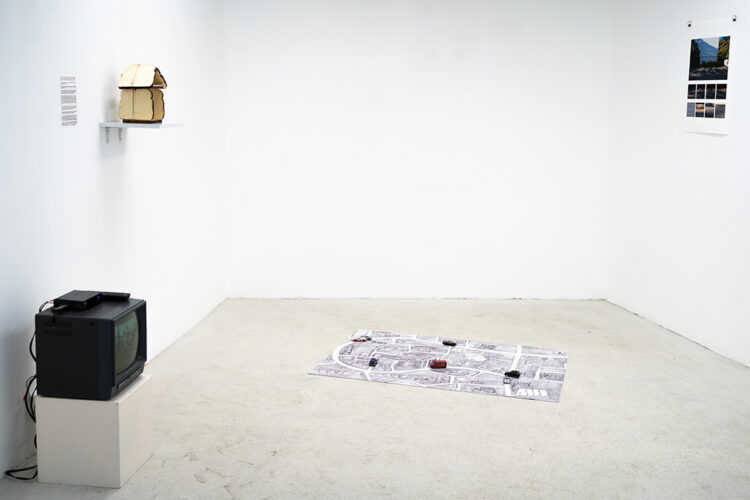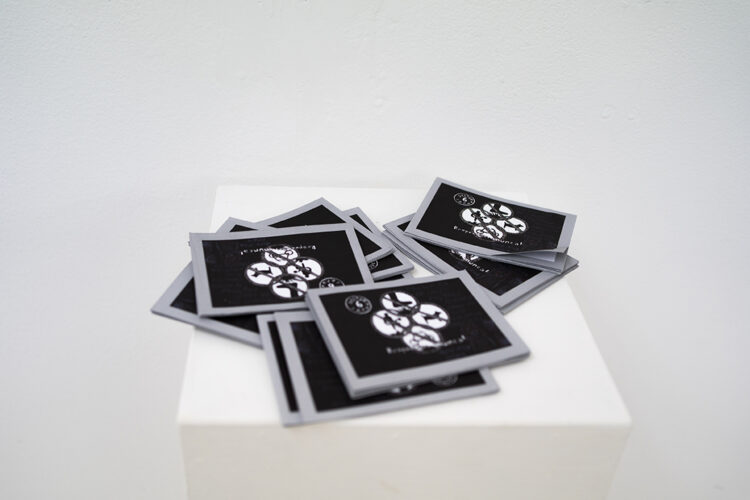The exhibition “The beat-looking grass lying around”, recently opened at Matca Artspace in Cluj Napoca, takes an affective approach to the Bucharest neighborhood of Drumul Taberei and proposes a reflection on how urban transformations have impacted the evolution of community identity. The exhibition is part of the project Oraș în Buclă: cercetare critică creativă în cartierul Drumul Taberei, organized by the REC Association with the support of AFCN, to encourage artistic research, guided by experienced mentors, as a model of creative partnership, a methodology based on a way of creating, thinking and acting following affective experimentation of the territory. The exploration of this research direction is realized through study and creation sessions, guided tours, exhibitions and presentations in Romania and the Republic of Moldova. The works resulting from the research sessions have been exhibited and presented in Cluj, Sibiu, Timișoara, Chișinău, the hometowns of the participating artists, as well as in Bucharest, thus providing a platform for dialog and cultural dissemination. Throughout the project, the two curators, Iris Ordean and Raluca Paraschiv, were able to provide a platform for investigating critical and explorative modes of communication and intermediation of artistic experience.
The series of works in the exhibition manages to capture a neighborhood on the border between past and future, exploring the human connection with an urban space that is constantly changing. Initially dominated by socialist modernist architecture, the layout of the neighborhood has evolved over time. Built around a looping artery, Drumul Taberei has become Bucharest’s greenest neighborhood, recently impacted by the consequences of today’s real estate pressures.
Six artists, Ana Kun, Alexandra Mocan, Mihai Moldovanu, Matei Toșa and the duo Alexandra Coroi & Bogdan Dumitrescu, lived in the neighborhood, in an ordinary apartment, acting as participant-researchers, critical observers and ethnographers. Meanwhile, four other artists, winners of the call for projects for young students and graduates, Eva Chapkin, Claudia-Maria Davidescu, Vlad Dragne and Ruxandra Nițescu, extended the identity of the interventions. The resulting works explore affective geographies, social issues and belonging based on artistic observation.
Artist Ana Kun has produced a series of ten illustrated postcards, with drawings and texts inspired by field observations and memories told by mentors. The works were sent from Timisoara to Bucharest and mailed from Drumul Taberei to the Matca gallery in Cluj, where they were exhibited. The series, also reproduced in a fanzine offered free to visitors, provides an intimate insight into lived experiences and shared stories. The versatile subjects of the artist’s observation of the territory are drawn from often overlooked areas. The human eye seeks the pleasurable, but Ana Kun focused on the neighborhood’s utilitarian spaces, often unnoticed but intimately connected to the daily lives of its residents. The experimental journey of the works through the post, marked by the seal of the Drumul Taberei office, adds a touch of charm for those who view them.
The duo Alexandra Coroi & Bogdan Dumitrescu investigates the neighborhood seen as a nostalgic territory and, at the same time, a space of collective coexistence. The works of the two explore the neighborhood with references to childhood. In the two video works, the artists approach spatial discovery through the ingenuity of children’s games. Dacă te concentrezi suficient de mult (If you concentrate hard enough) explores the playful idea of running through predefined paths. The artist’s story about building the concept of one of the works Să nu te pierzi prin cartier (Don’t Get Lost in the Neighborhood) caught my attention on the exhibition tour. The work was constructed through “affective-creative” writing exercises with imagined histories of a labyrinthine neighborhood. Their latest series of works, Acțiune 01, Acțiune 02 and Acțiune 03, illustrate photographic interventions on the reality of the urban landscape colonized by machines. With a critical character, the artists address the common areas and pedestrian spaces annoyed by the presence of parked cars.
Similarly, artist Claudia-Maria Davidescu outlines the everyday character of the neighborhood, tracing the daily itinerary of three inhabitants. The work, realized by weaving in vertical latticework, emphasizes the close connection of the three characters investigated with the space in which they live.
Alexandra Mocan proposes to reconstruct a section of the neighborhood’s recent history, namely the construction of one of the area’s major shopping centers. The controversial construction was initiated through public consultation sessions with specialists, but few of the issues discussed there have made their way into the current functions of the space. Using the technique of rear projection, the artist intervenes on a lightbox in the work Și aici ne separăm (Abd this is where we get separated) in which she transforms the name of the neighborhood into Drumurile Taberelor by using the plural and borrows the specific font of the shopping center that replaced the former Tricodava factory, thus criticizing the promotion of acutely commercial values that divide instead of unite and form consumers instead of communities.
Matei Toșa brings the everyday images of the city into a graphic dimension and invites the public to interact with the work Nostalgic Kingdom. As part of the research, the artist made a succession of transpositions of the neighborhood map, which were then transferred onto a textile-printed surface. The work has a playful character, both in its tactile exploration through play with the intervention of toy machines, and in its positioning on the floor, recalling childhood games. In a different logic, the work Acțiune 03 placed in proximity, reflects a critical perspective on the presence of vehicles in public spaces. It problematizes how the quality of the urban environment is affected by the suffocating presence of cars, the artistic intervention contouring a re-evaluation of the relationship between man, car and home.
Mihai Moldovanu brings to light the results of a research carried out, due to the stifling heat in August, mainly at night. The night, when everyday life takes a break, helps him capture the anguish of the neighborhood, transposed in the work Fațade și coridoare (Facades and Corridors). In his video work, the artist initiates an investigation based on the principle of dérive, which was tackled by the international group of situationists in the 60s. Drifting through the neighborhood, the artist becomes increasingly preoccupied with the relationship between populated spaces and absence, mainly due to the climate crisis that is becoming an increasingly pressing daily reality.
Another key area of the neighborhood is put under the spotlight through Vlad Dragne’s installation Cronicile șantierului etern (The Chronicles of the Eternal Construction Site). The artist draws on his own experience from an early video montage he made in 2018 about the demolition of the Favorit cinema. The current work, which revisits the same route, now a construction site for the future Favorit Cultural Center, captures the tension between the local community and the remodeling of the space, marked by skepticism.
Ruxandra Nițescu traces the small-town character of the neighborhood of 350,000 inhabitants through the work Cartografiere în 10 mii de pașii (Cartography in 10 thousand steps). The affective-auditory work made in Drumul Taberei emphasizes the areas frequented by the inhabitants, managing to connect the common spaces with the sounds of architectural developments. The artist draws our attention to the sounds that surround us in everyday life, tracing her itinerary on a BCA brick, a symbol of contemporary urban transformations and expansions.
Eva Chapkin is the author of an installation based on the experience of a romantic encounter in adolescence. Her work explores the idea of the house as a symbol of community and intimacy, carved from wood and wire, with sliced bread walls evoking a nostalgic and fragile future. Through a performance transposed on video, the artist relives a dream from her adolescence, traveling with this “bread house” through the streets of Drumul Taberei, inviting the viewer to reflect on the idea of home as an essential, nurturing and intimate space.
The exhibition “The beat-looking grass lying around” can be visited until the 20th of November at Matca Artspace. Closing: November 20, 18:00 – 21:00.
Translated by Liliana Popescu
POSTED BY
Daniela Domuța
Daniela Domuța, who believes curating is a form of art, tries to make art more accessible to the world by leading it to create meaningful experiences. She developed her curatorial and artworld backgr...















Comments are closed here.